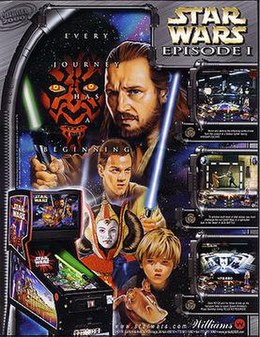 | |
| Manufacturer | Williams |
|---|---|
| Release date | June 1999 [1] |
| System | Williams Pinball 2000 |
| Design | John Popadiuk |
| Programming | Cameron Silver, Duncan Brown |
| Artwork | Dave Mueller, Paul Barker, Kevin O'Connor |
| Mechanics | Jack Skalon, Bob Brown |
| Music | Eric Pryzby |
| Sound | Eric Pryzby |
| Website | Star Wars Episode I |
| Production run | 3,525 units (confirmed) |
Star Wars Episode I is a 1999 pinball game designed by John Popadiuk and released by Williams and the second (and last) machine to use the Pinball 2000 hardware platform. It is based on the first installment of the Star Wars prequel trilogy, The Phantom Menace .
Contents
Released in June 1999, Star Wars Episode I was the last game manufactured by WMS industries (Williams and Bally labels) before the company announced the closure of their pinball division on October 25 of the same year, [2] with production ceasing on November 19. [3] The jet bumper rule of the 1.4 software reminds players of that date: The number of points for spelling Jar Jar is 19,992,510; This is the date 25-10-1999, the same day WMS announced the closing of their pinball branch.
The game was also available as a conversion kit for Revenge From Mars which included a Star Wars Episode I playfield, game ROMs, manual, cabinet decals, translite and a manual plunger.